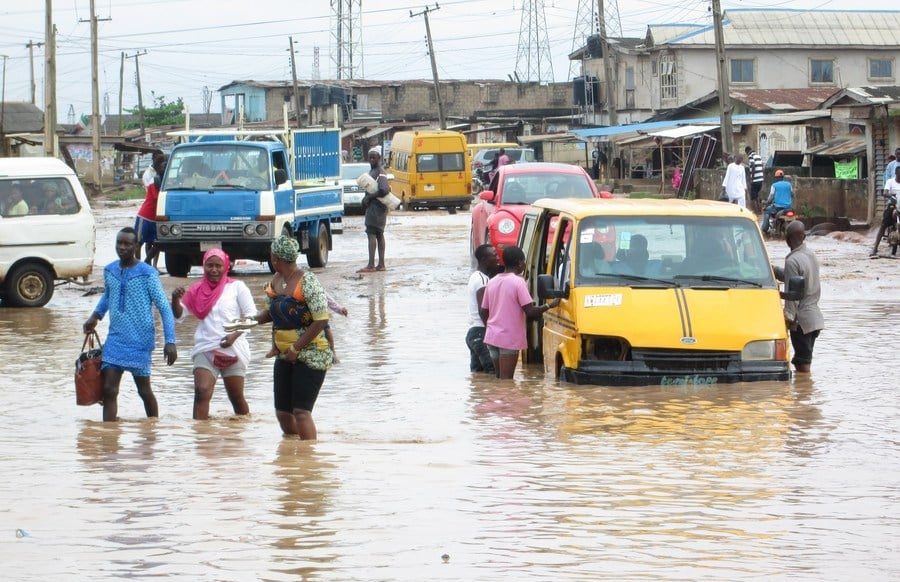Editorial
Flooding: That Nigeria May Stop Catching Cold When Cameroon Sneezes

As the supposed giant and big brother of Africa, countries on the continent should be the ones catching cold when Nigeria sneezes, not the other way around. It is, therefore, contradictory for Nigeria to degenerate to the level where Cameroon’s sneeze forces it to catch cold. This was exactly the case when Cameroonian authorities announced their intention to open the floodgate of Lagdo dam “in days ahead, due to heavy rainfall around the dam catchment area in the northern part of the country”.
This was the crux of the letter dated August 21, 2023, and signed on behalf of the Francophone country’s Permanent Secretary of the Foreign Affairs ministry by Umar Salisu, Director, African Affairs, addressed to the Director General of the National Emergency Management Agency. It then urged Nigeria’s NEMA to take “necessary proactive steps and actions that will mitigate the damage as well as sensitize the populace living in such areas for vigilance and all necessary precautions”. This has since sparked panic in Nigeria so much so that NEMA had to issue a statement “to allay the fears of Nigerians” as the agency “envisaged this release of excess water from the Lagdo dam, taken note of the likely impacts and considered in the preparations for mitigation and response to the 2023 flood alert”.
The Lagdo dam is located along River Benue in the Republic of Cameroon and has a history of overflooding some Nigerian states that are along its navigation ways. This is largely felt in about 13 states in Nigeria namely: Kogi, Benue, Adamawa, Bauchi, Borno, Gombe, Taraba, and Yobe. Others include Niger, Nasarawa, Kebbi, Kogi, Edo, Delta, Anambra, Cross River, Rivers, and Bayelsa States. Since the neighbouring country made its intention known, there has been palpable panic in Nigeria given that the country is yet to fully recover from the monumental devastation caused by a similar exercise in 2022.
No fewer than 2,504,095 Nigerians were affected by floods across the country that followed the release of water from the Lagdo dam in 2022. Then Minister of Humanitarian Affairs, Disaster Management and Social Development, Sadiya Umar Farouq, while giving a breakdown of the tragedy disclosed that 1,302,589 people were displaced and 2,407 people injured, while 603 people were killed. Again, 121,318 houses were partially damaged, 82,053 houses were totally destroyed, 108,392 farmlands were partially damaged with 332,327 others submerged.
Only this morning, a national TV station was reporting how the East-West road which was severely damaged by the floods of last year is still in a state of disrepair with residents of Bayelsa expressing apprehension over the fate that awaits them should there be a recurrence this year. It is also fresh in memory how the flooding of Lokoja during the flash rains of 2023 cut off commuters in southern Nigeria from getting to the federal capital territory. The unfortunate development even resulted in fuel scarcity in Abuja and some northern states because trucks conveying petrol could not wade through the flood, hence had to spend days on a spot until the water receded.
When similar flooding still tied to the release of water from the Lagdo dam happened in 2012, NEMA reported that over 400 people were killed, more than 6,000 houses were destroyed and seven million people were displaced with the losses put at over a whopping $17bn! The bursting of river banks submerged vast lands in 30 of the country’s 36 states. In 2019, a total of 277,555 people were affected by floods and 158 were killed. In 2020 the number of those affected by floods rose to 2,353,647. Given this history and cost implications, it is beyond Naija News why successive Nigerian governments have allowed the lives, livelihoods and properties of her citizens to remain at the mercy of Lagdo dam and climate change.
It is not as if the federal government is bereft of a permanent and even beneficial solution to this catastrophic challenge. After the devastating floods of 2012, the then Director of Dams in the Ministry of Water Resources, Dr. Emmanuel Adanu, reportedly said, “It is now imperative for the Federal Government to build a bumper dam to cushion the effect of water released by Lagdo Dam. The size of the dam we are looking at will take us 36 months to finish it, but right now we know that the original feasibility study that was done in 1982 is a bit outdated. The Cameroonian government finished constructing the Lagdo dam in 1982, but Nigeria is yet to develop its own dam. So anytime the Cameroonian government wants to release water from the dam, they always alert the Nigerian government so as to evacuate people to avert casualties.”
Naija News demands that the government immediately update the design and get on with constructing the dam said to have been sited in Dasin Village of Fufore Local Government Area of Adamawa State. It is regrettable that a country like Cameroon which is significantly less populated than Nigeria had better foresight in staving off the fury of flood by constructing the Lagdo dam. Yet, the Nigerian government is not ashamed to seasonally issue flood alerts and request citizens on flood plains to relocate from their homesteads to higher grounds, as if it is that easy to find shelter or a new home.
It’s not even as if the government lacks the means of constructing this highly critical infrastructure what with the cost of corruption to the country. Two days ago, the House of Reps ad-hoc committee probing the utilization of Ecological Funds and other intervention funds of the Great Green Wall Project was alarmed to learn that the National Agency for Great Green Wall spent N81bn to plant 21 million trees in 11 frontline states in the north. Tales of such misappropriation and siphoning of public funds abound in various government agencies. It’s time these revenue leakages and corruptions are blocked to free up funds badly needed to construct the dam that will save Nigerians from flood fury.
Nigeria having flood control dam along Rivers Niger and Benue will come with the added benefits of enabling dry season farming with the irrigation of no fewer than 150,000 farmlands, boosting electricity generation, providing jobs and holding 20,000 tons of fish annually. If successive administrations were blind to this, the Tinubu government must not, as the Chinese proverb says: “The best time to plant a tree was 20 years ago. The second best time is now”. Over 16 million Nigerians are currently affected by humanitarian crises caused either by man-made occurrences or natural disasters. Adding this to the 133 million Nigerians presently living in multidimensional poverty is enough compelling reason why flooding must not be allowed to push more Nigerians into the misery index.
We also call on the government to dredge rivers in the country to reduce siltation and sedimentation. It will be in Tinubu’s interest to take up the challenge of building flood control dam in Nigeria so that should Cameroon get caught up in the current coup contagion as the country has a lot in common with states ruled by coup makers, Tinubu can as the ECOWAS Chairman throw his weight around as he has been doing to the Niger Republic putschists.











